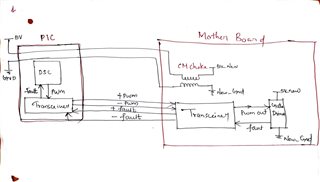Hello Experts,
I have a DSC card stacked in Peripheral interface card (PIC) both having common power supply 5V and GND. The transceiver IC placed in the PIC is powered by this same 5V and the signals are connected to the transceiver IC in mother board through FRC ribbon cables. But in mother board, The 5V from the PIC is passed through a emi filter and this new5V and newGND powering the transceiver ic in mother board. The gate driver ic also powered from this new5V.
1. Does this connection can make any ground elevation ? The CM choke have a 0.5mOhs DC resistace.
2. Is it necessary that both Transceiver ICs shall powered with same ground.? if i replace the common mode choke with a 5V to 5V isolated DC power supply, does this transceiver circuits works ?
Regards
Anoop kumar


